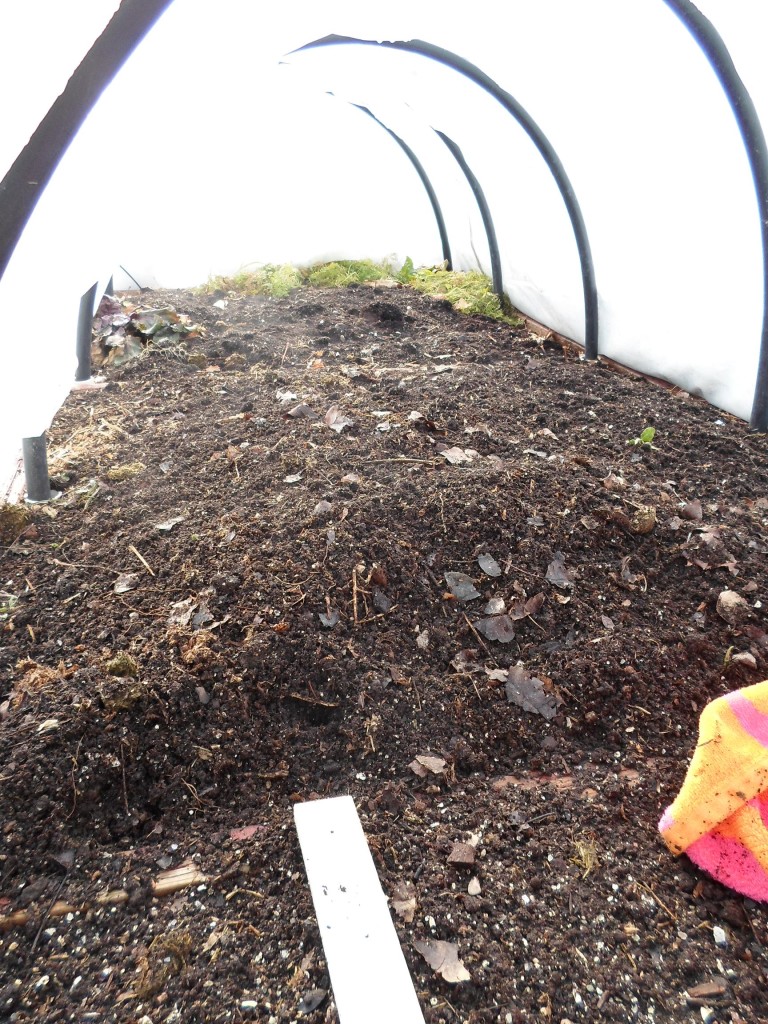 The recorded windchill temperatures at night have been in single digits all week. I haven’t been able to see anything that’s come up yet but I’ve been able to take a quick peek under the plastic to observe what the picture shows if you look hard enough-heat coming up from the ground. The sun has come out occasionally but I haven’t put a thermometer under the plastic to know how warm it’s gotten. Past experience has shown it to be 30+ degrees warmer then the outside air. I planted another square today of lettuce and radishes which means there should be eight squares growing soon-hopefully. I’ve got all cold crops planted under the tunnel so we’ll see if this little experiment works. The towel under the tunnel(previous post picture)has been used to cover the squares that have been planted so far. It’s just meant to provide another layer of protection-especially in this kind of weather.[ois skin=”below post”]
The recorded windchill temperatures at night have been in single digits all week. I haven’t been able to see anything that’s come up yet but I’ve been able to take a quick peek under the plastic to observe what the picture shows if you look hard enough-heat coming up from the ground. The sun has come out occasionally but I haven’t put a thermometer under the plastic to know how warm it’s gotten. Past experience has shown it to be 30+ degrees warmer then the outside air. I planted another square today of lettuce and radishes which means there should be eight squares growing soon-hopefully. I’ve got all cold crops planted under the tunnel so we’ll see if this little experiment works. The towel under the tunnel(previous post picture)has been used to cover the squares that have been planted so far. It’s just meant to provide another layer of protection-especially in this kind of weather.[ois skin=”below post”]
What a difference a couple of days can make
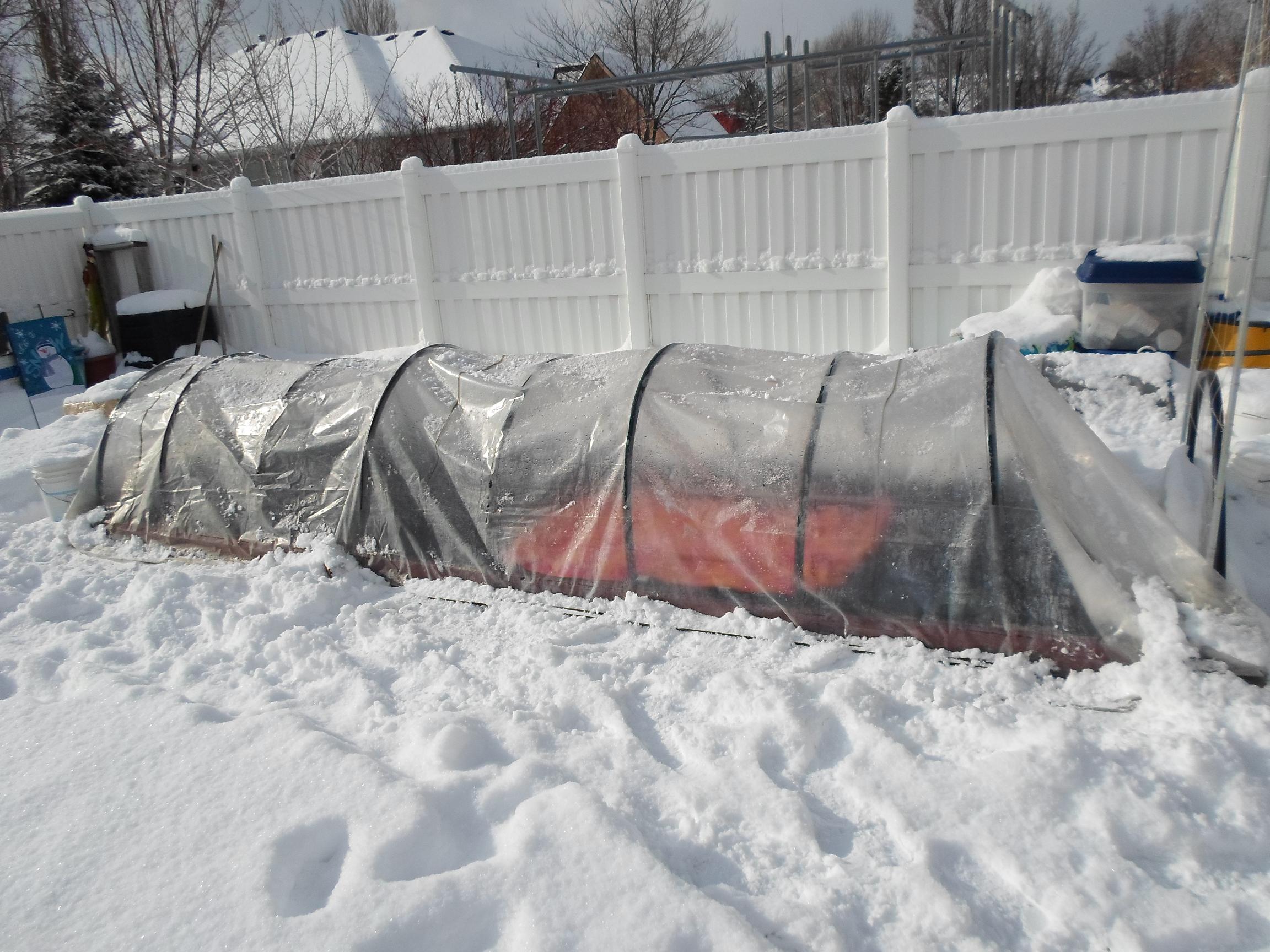 We’ve been hit hard with a lot of snow the past few days. This is what the high tunnel looks like after a little sunny weather. In a few days I’ll post a picture of what it looks like underneath as I’ve got 7 things planted under there right now. With night temperatures in the mid to high teens it’ll be interesting to see if anything under the tunnel actually grows. I think it will. I snapped a picture under the tunnel earlier today and you can see steam rising from the soil-a good sign. I’m not quite sure about this, but I think my brussel sprout plant has actually started to grow again. Pretty fun stuff.
We’ve been hit hard with a lot of snow the past few days. This is what the high tunnel looks like after a little sunny weather. In a few days I’ll post a picture of what it looks like underneath as I’ve got 7 things planted under there right now. With night temperatures in the mid to high teens it’ll be interesting to see if anything under the tunnel actually grows. I think it will. I snapped a picture under the tunnel earlier today and you can see steam rising from the soil-a good sign. I’m not quite sure about this, but I think my brussel sprout plant has actually started to grow again. Pretty fun stuff.
[ois skin=”below post”]
Step one in prepping your square foot garden in winter
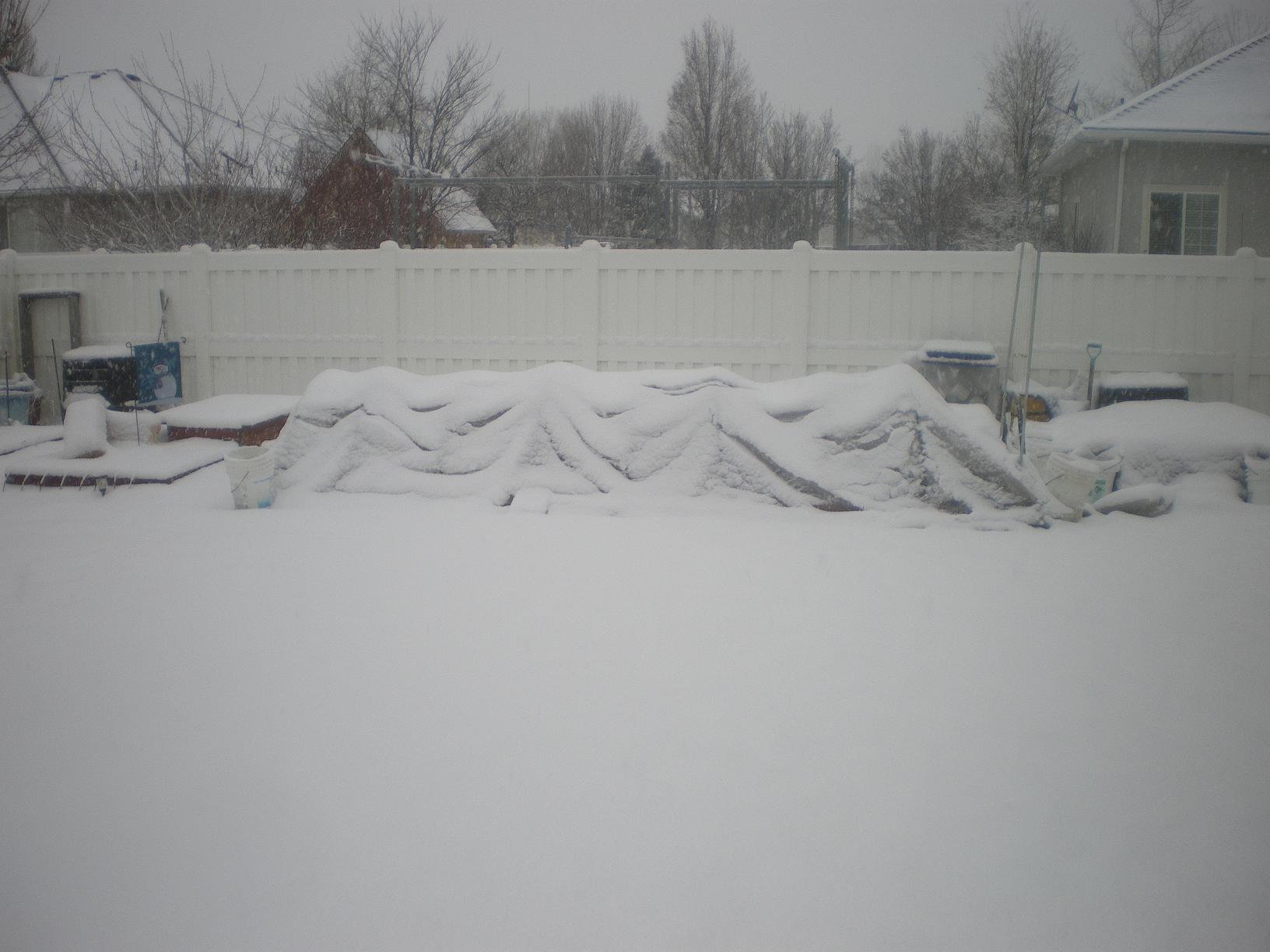 We live in Zone 6 here in Salt Lake City. The weather usually has people thinking that gardening season is over. I think they’re right-for the warm weather crops. This will be my winter experiment. Can I grow garden produce and vegetables right through the winter despite the snow and extended freezing temperatures? What I really should’ve done was to have my gardens planted in early October for winter harvesting vs. winter gardening. I’ve grown in late winter before, but those gardens started in the 3rd week of February. January is our coldest month so this will be a challenge. You’ve probably seen how I’ve prepped my soil in the fall from previous posts. After 13 years my soil of Mel’s mix is now 100% compost. It’s a heavier soil mix but still perfectly suited to do anything you need. Given the fact that the soil is as good as it can be, the next thing I have to do is thaw out the soil. I went back to the gardens the other day and tried to put a pitch fork into the soil-no go. It was frozen solid. So I need to heat the place up. You can see my method from the picture-an unheated greenhouse. This is nothing more than flexible PVC held in place by re-bar inside the SFG boxes. Now all I need to do is cover it with plastic-the equivalent of putting a sweater over my boxes. The trick is to take advantage of free solar energy(sun)to then warm your soil in preparation to start planting. Your biggest challenge is to protect your garden from the wind(think windchill.) By covering with plastic you’ll also be able to protect your plants from wet/freeze/dry periods. This is what’s really hard on plants. The last key is growing things that don’t mind cold weather. I think one of the biggest mistakes we sometimes make is trying to make warm weather crops-summer items-grow in the off-season. Why force it? Growing cold weather things will make your job a lot easier. And the cold weather will take away some of the bitterness associated with some of these crops. Because your gardens are limited in size with the square foot gardening system, it then becomes much easier to protect and take care of it. With just one layer of plastic your boxes will be at least 30 degrees warmer during the day. At night-about 15 degrees, maybe a little higher. Two days after this snowstorm hit my soil was cold but no longer frozen. I should be ready to plant in about another 4 or 5 days. Just cover your garden, heat it up, make sure you’re choosing cold weather crops, and you’ll be ready to plant in about a week-two weeks at the most. I hope you’ll come back to visit so you can follow this winter garden experiment.
We live in Zone 6 here in Salt Lake City. The weather usually has people thinking that gardening season is over. I think they’re right-for the warm weather crops. This will be my winter experiment. Can I grow garden produce and vegetables right through the winter despite the snow and extended freezing temperatures? What I really should’ve done was to have my gardens planted in early October for winter harvesting vs. winter gardening. I’ve grown in late winter before, but those gardens started in the 3rd week of February. January is our coldest month so this will be a challenge. You’ve probably seen how I’ve prepped my soil in the fall from previous posts. After 13 years my soil of Mel’s mix is now 100% compost. It’s a heavier soil mix but still perfectly suited to do anything you need. Given the fact that the soil is as good as it can be, the next thing I have to do is thaw out the soil. I went back to the gardens the other day and tried to put a pitch fork into the soil-no go. It was frozen solid. So I need to heat the place up. You can see my method from the picture-an unheated greenhouse. This is nothing more than flexible PVC held in place by re-bar inside the SFG boxes. Now all I need to do is cover it with plastic-the equivalent of putting a sweater over my boxes. The trick is to take advantage of free solar energy(sun)to then warm your soil in preparation to start planting. Your biggest challenge is to protect your garden from the wind(think windchill.) By covering with plastic you’ll also be able to protect your plants from wet/freeze/dry periods. This is what’s really hard on plants. The last key is growing things that don’t mind cold weather. I think one of the biggest mistakes we sometimes make is trying to make warm weather crops-summer items-grow in the off-season. Why force it? Growing cold weather things will make your job a lot easier. And the cold weather will take away some of the bitterness associated with some of these crops. Because your gardens are limited in size with the square foot gardening system, it then becomes much easier to protect and take care of it. With just one layer of plastic your boxes will be at least 30 degrees warmer during the day. At night-about 15 degrees, maybe a little higher. Two days after this snowstorm hit my soil was cold but no longer frozen. I should be ready to plant in about another 4 or 5 days. Just cover your garden, heat it up, make sure you’re choosing cold weather crops, and you’ll be ready to plant in about a week-two weeks at the most. I hope you’ll come back to visit so you can follow this winter garden experiment.
[ois skin=”below post”]
Winter gardening
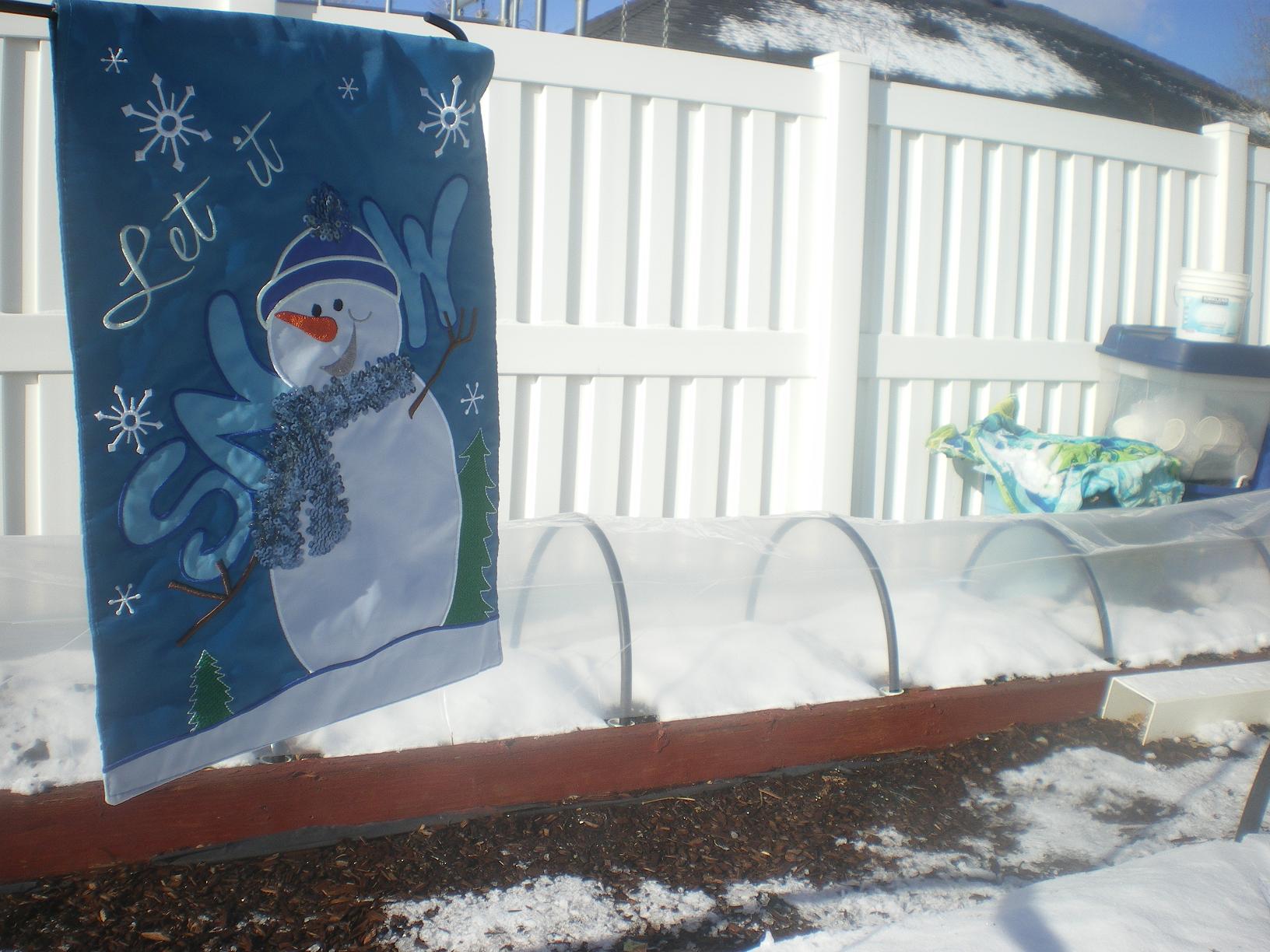 I’ve just finished reading a great book on winter gardening(thanks Brynn!)by Eliot Coleman. The basic premise is this: most of the United States is south of the 44th parallel. If you were to look at where this is you’ll see that the majority of Europe is further north than we are in the U.S. But in Europe gardening doesn’t stop in winter-it’s traditionally carried right on through. Yet in the U.S., at least in the more difficult to grow climates(zone 6 and below), it’s our tradition to close the gardens down in the winter. Why fight the weather? In this book the author lists between 20 and 30 vegetables and produce items that can easily be grown in cold weather. In fact, the things that he’s grown only do well in cold temperatures. In France, unheated greenhouses are used to grow all of these items because it keeps the wind off the plants and can add another 10-15 degrees to the outside temperature and maybe even more. It was a fascinating read. What he does is plant in late October(Maine-zone5). By the time everything grows and it’s time to start harvesting he and his wife are able to eat all winter long right out of the garden. The key was to have it planted before the harsh weather hits. He uses winter to harvest, not to plant. He also takes time to discuss building a cold frame and low tunnels. By using these you get the equivalent of moving up 1 to 1 1/2 zones. So if your typically in zone 5 and protect your gardens with low/high tunnels, you just became the equivalent of zone 6 to 6 1/2. This changes things significantly. I got to thinking-I’ve got low tunnels and cold frames that I’ve used for years. Mine aren’t nearly as expensive as Elliot’s but they accomplish the same thing. So I’m starting right now. I’ve got the tunnels on my two main square foot garden beds. In a few days my garden should be ready to start planting. I’ll be planting in winter vs. harvesting in winter which might be different. This is the earliest I’ve ever started and I’m anxious to see how the experiment turns out. Can you imagine over 20 different things to harvest in the months of December through March in most of these colder zones? Wow. I’m going to be doing that next year too.
I’ve just finished reading a great book on winter gardening(thanks Brynn!)by Eliot Coleman. The basic premise is this: most of the United States is south of the 44th parallel. If you were to look at where this is you’ll see that the majority of Europe is further north than we are in the U.S. But in Europe gardening doesn’t stop in winter-it’s traditionally carried right on through. Yet in the U.S., at least in the more difficult to grow climates(zone 6 and below), it’s our tradition to close the gardens down in the winter. Why fight the weather? In this book the author lists between 20 and 30 vegetables and produce items that can easily be grown in cold weather. In fact, the things that he’s grown only do well in cold temperatures. In France, unheated greenhouses are used to grow all of these items because it keeps the wind off the plants and can add another 10-15 degrees to the outside temperature and maybe even more. It was a fascinating read. What he does is plant in late October(Maine-zone5). By the time everything grows and it’s time to start harvesting he and his wife are able to eat all winter long right out of the garden. The key was to have it planted before the harsh weather hits. He uses winter to harvest, not to plant. He also takes time to discuss building a cold frame and low tunnels. By using these you get the equivalent of moving up 1 to 1 1/2 zones. So if your typically in zone 5 and protect your gardens with low/high tunnels, you just became the equivalent of zone 6 to 6 1/2. This changes things significantly. I got to thinking-I’ve got low tunnels and cold frames that I’ve used for years. Mine aren’t nearly as expensive as Elliot’s but they accomplish the same thing. So I’m starting right now. I’ve got the tunnels on my two main square foot garden beds. In a few days my garden should be ready to start planting. I’ll be planting in winter vs. harvesting in winter which might be different. This is the earliest I’ve ever started and I’m anxious to see how the experiment turns out. Can you imagine over 20 different things to harvest in the months of December through March in most of these colder zones? Wow. I’m going to be doing that next year too.
[ois skin=”below post”]
Brussel sprouts
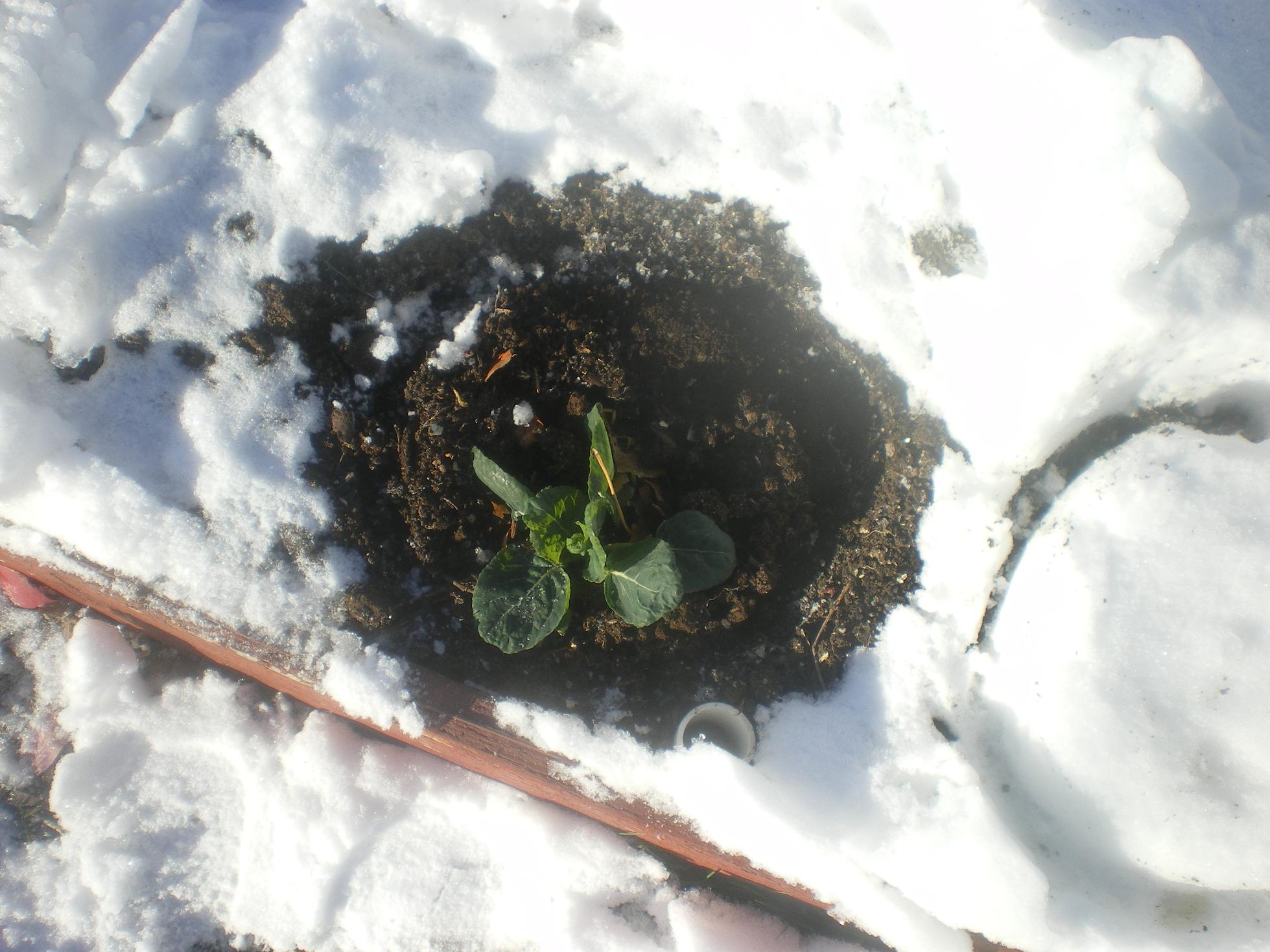 Here’s a little something for you snow SFG’ers. Toward the end of this past years growing season I wanted to plant brussel sprouts. I purposely waited until later because I’ve had so much trouble growing it in the spring and summer. The problem in the past has been the white butterfly. So I thought to myself, why don’t I grow these later in the year when the white butterfly is gone? It’s kind of the same strategy some people use with squash-they’ll plant squash a little later-after the threat of squash bugs has past. I like that thinking but in shorter season climates such as we have, it might not give you enough time to grow your squash. Right off the top of my head I don’t remember when I planted this but it was sometime in late July I think. I was hoping to get this growing and established for a winter crop and I was planning on protecting it through the winter. Knowing that these little nuggets taste better after a frost, my goal was to get the plant big enough and established in time before the real hard winter weather got here. I don’t think I made it. But I didn’t want to just pull it up and throw it out. So I’ve decided to keep it going and see what happens. I’ll still cover it in bad weather. I actually has grown some-though very slowly. We’ve had 6-8 inches of snow this past week, with another 5-10 inches coming tonight. I’ll cover it today to keep the weight of that snow off the plant. I don’t know what this will look like going forward. I’ve read that brussel sprouts can go into a dormant stage and then start growing in the spring. If that’s the case this might work. Maybe when everything starts to thaw and warm up this brussel sprout plant will begin to grow again in late winter. If it gets big enough in early spring and starts growing the actual brussel sprouts, it could be great. At that time we’ll still have enough weather that brings frost which will increase the taste of the brussel sprouts. We’ll see how it all turns out.
Here’s a little something for you snow SFG’ers. Toward the end of this past years growing season I wanted to plant brussel sprouts. I purposely waited until later because I’ve had so much trouble growing it in the spring and summer. The problem in the past has been the white butterfly. So I thought to myself, why don’t I grow these later in the year when the white butterfly is gone? It’s kind of the same strategy some people use with squash-they’ll plant squash a little later-after the threat of squash bugs has past. I like that thinking but in shorter season climates such as we have, it might not give you enough time to grow your squash. Right off the top of my head I don’t remember when I planted this but it was sometime in late July I think. I was hoping to get this growing and established for a winter crop and I was planning on protecting it through the winter. Knowing that these little nuggets taste better after a frost, my goal was to get the plant big enough and established in time before the real hard winter weather got here. I don’t think I made it. But I didn’t want to just pull it up and throw it out. So I’ve decided to keep it going and see what happens. I’ll still cover it in bad weather. I actually has grown some-though very slowly. We’ve had 6-8 inches of snow this past week, with another 5-10 inches coming tonight. I’ll cover it today to keep the weight of that snow off the plant. I don’t know what this will look like going forward. I’ve read that brussel sprouts can go into a dormant stage and then start growing in the spring. If that’s the case this might work. Maybe when everything starts to thaw and warm up this brussel sprout plant will begin to grow again in late winter. If it gets big enough in early spring and starts growing the actual brussel sprouts, it could be great. At that time we’ll still have enough weather that brings frost which will increase the taste of the brussel sprouts. We’ll see how it all turns out.
[ois skin=”below post”]

